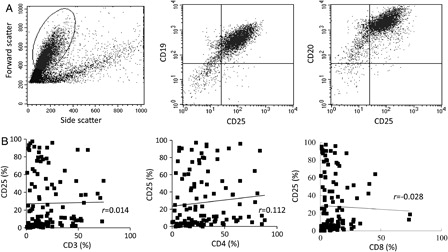Figures & data
Figure 1. CD25 expression in DLBCL. DLBCL cells are identified by forward and side scatter properties, and CD25 expression on the cells is shown using two-color flow cytometry (A). There is no relationship between CD25-positivity and one of CD3, CD4, and CD8-positivity (B) in the gated regions. r, correlation coefficient.

Figure 2. Kaplan–Meier estimates of PFS (A) and OS (B)for DLBCL patients treated with R-CHOP in accordance with CD25-positivity. According to CD25-positivity in the gated regions, three groups are clearly separated: more than 60%, 20–60%, and less than 20% CD25-positivity.

Table 1. Patient characteristics according to CD25 expression
Figure 3. Kaplan–Meier estimates of PFS (A) and OS (B) for patients with CD25-high and CD25-low DLBCL treated with R-CHOP. CD25-high and CD25-low indicate 60% or more CD25-positivity in the gated regions and less than 60% positivity in the regions, respectively.

Table 2. Response to R-CHOP chemotherapy